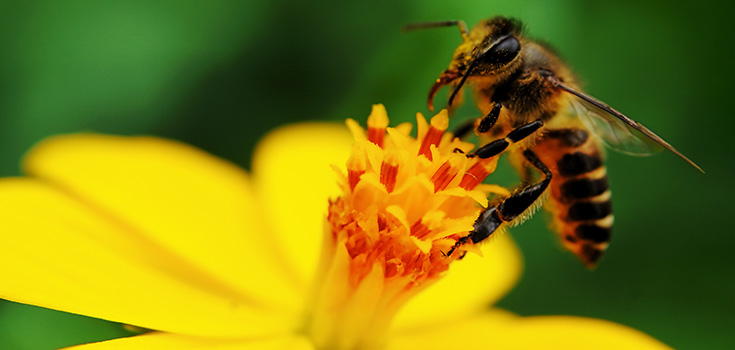Amazing Bee Products that Cure and Protect

There are those who swear by its rejuvenating and energizing benefits. And there are others who dismiss those claims while mentioning allergic reaction dangers. This area of controversy involves super food bee products: Honey Bee pollen, propolis, and Royal Jelly.
Defining Honey Bee Super Foods
Bee pollen is a granular composite of pollen from various plants and flowers compacted with a sticky substance from the bee. It’s usually collected by bee keepers from bees returning to the hive by forcing the bees to enter the hive through openings that force the bees’ collected pollen from their leg sacs.
Each grain of bee pollen, visually similar to a raw steel cut oat, is a composition of elements that cannot be synthetically reproduced. Bees fed synthetic bee pollen die. Yet naturally created bee pollen is what is fed to the hive’s bees. This food could be considered a form of “flower power.”
Bee pollen has been used for anti-aging, overall health, and energy boosting. Some swear by it, and others swear at it because they don’t get their desired results. This is true with many nutrient super foods. One size doesn’t fit all. Nevertheless, some research scientists have tagged bee pollen as one of nature’s perfect foods.
Athletes, intense exercisers, and performers or workers involved with physical endurance maintain that their energy levels are improved with regular bee pollen intake. One thing that is for sure, bee pollen is an excellent natural source of all the B-vitamins.
Propolis is often called bee glue because it is produced by worker bees to construct, protect, or repair their hives. They produce it by combining tree resins with pollen, beeswax, and nectar.
Even some naysayers and quack watchers acknowledge lab research that cites propolis’ ant-viral, anti-bacterial, anti-inflammatory, anti-oxidant, and anti-tumor aspects. Propolis is medicinal and has been used for centuries. Today it is commonly used for colds, flues, and other minor ailments.
Royal Jelly is secreted by worker bees and fed to bee larvae for the first three days. But the queen bee feeds on it for life, thus the name Royal Jelly. Some holistic health practitioners claim it’s useful for a variety of serious health conditions, including hepatitis, asthma, arthritis, ulcers, and kidney disease.
There are no clinical trials to substantiate those medicinal claims or results. But then again, it’s rare that clinical trials, which are usually slanted to pharmaceutical companies’ bottom line interests, are applied to non-pharmaceuticals. However, most agree that Royal Jelly is a very nutritious dietary supplement for overall health and anti-aging.
Combining All Honey Bee Products Into One
Perhaps the best way to get the most benefits is to combine the three items explained into one supplement product, or put those three in a base of honey to make it a four ingredient bee product.
You would be getting all 22 amino acids in one natural food. Though you can get all 22 amino acids in any one of the bee foods mentioned in this article, the synergistic value of combing all three or all three with honey is considered optimum by many.
Other nutritional benefits are the B vitamins, most of the other vitamins, and most essential minerals. Rita Elkins, author of Healing from the Hive, and J.S Taylor, author of Power of the Beehive, both wrote of a special synergy that cannot be reproduced in laboratories from combining all four bee products.
Manuka honey alone is even used in some New Zealand hospitals to prevent MRSA super bug infections. Other than Manuka honey, it’s best to find organic local bulk honey when you shop. And without pollen residue, honey is not honey. Even the FDA says that.
Words of Caution
A small percentage of the human population is very allergic to bee venom and bee products, and sometimes they can go into extreme shock. If unsure, try a small amount of any of the three earlier bee products to determine whether you’re allergic or not. Sneezing or developing a rash or any negative reaction is an indication that you may be allergic.
Otherwise, make sure your bee products come from pristine, relatively unpolluted areas.
Additional Sources:

El propóleo es una mezcla resinosa que las abejas recolectan de las yemas de árboles, los flujos de savia, o de otras fuentes botánicas. Se utiliza como un sellador para espacios abiertos no deseados en la colmena. El propóleos es utilizado para pequeños espacios (aproximadamente 6 mm (0,24 pulgadas) o menos), mientras que los espacios más grandes se llenan generalmente de cera de abejas. Su color varía dependiendo de su fuente botánica, el más común es de color marrón oscuro. El propóleos es pegajoso y por encima de la temperatura ambiente, 20 ° C (68 ° F). A temperaturas más bajas, se hace difícil y muy frágiles.
Honey is something that can preserve our bodily health. Not only that, honey also serves as a dietary supplement that can make our body become stronger and resistant to various diseases. Let us take honey regularly.